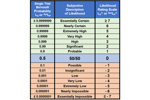ARTICLES BY MARK F. WITCHER
-
Reimagining HACCP And Other Process Flow Risk Analysis Methods Using Relational Risk Analysis12/17/2025
Combining relational risk analysis (ReRA) modeling strategies with hazard analysis and critical control point (HACCP) and other process flow risk analysis methods makes them more efficient.
-
Why Pharmaceutical And Medical Device Risks Must Be Analyzed By Their Risk Mechanisms9/16/2025
Current risk analysis methods focus on the possibility and severity of bad events instead of focusing directly on analyzing and improving the performance of systems and processes producing the bad events.
-
Minimizing The Impact Of Human Errors Using Relational Risk Analysis8/4/2025
This article describes how a mechanism-based risk analysis approach can provide two complementary opportunities for minimizing the likelihood of a human error impacting pharmaceutical and medical device risks.
-
Expanding A Bow Tie Risk Analysis Model Using Relational Risk Analysis6/2/2025
Relational risk analysis can be used to enhance and expand a bow tie analysis in the pharma and medical device industries to more effectively analyze risks as relationships between mechanisms and events.
-
Understanding The Impact Of An RMP On Patient Risks Using Relational Risk Analysis5/5/2025
Using relational risk analysis, let's take a closer look at risk management plans for identifying and managing adverse reactions for administering a new therapy to a patient.
-
Managing Contamination Risks In The Pharmaceutical And Medical Device Industries Using Relational Risk Analysis2/18/2025
Of all the risks associated with pharmaceuticals and medical devices, controlling contamination is one of the most important and difficult challenges. Relational risk analysis (ReRA) can help.
-
A New Approach For Minimizing Human Errors In Biopharmaceuticals And Medical Devices2/3/2025
Human errors account for many manufacturing failures, simply due to the roles in our activities and systems. Relational risk analysis (ReRA) fundamentally changes the way risks are analyzed.
-
A New Approach To ISO 14971 For Better Medical Device Risk Analysis10/23/2024
This article puts a new lens on the risk model in Annex C of ISO 14971 using relational risk analysis to describe a better approach for understanding and managing medical device risks.
-
System Failure Mode & Effects Analysis (SFMEA): An Alternative Approach For Analyzing Risks6/26/2024
Your company likely uses risk matrices and FMEA for analyzing risks. This article describes an alternative approach for conducting a system failure mode & effects analysis.
-
Managing Supply Chain Risks Using Relational Risk Analysis4/5/2024
In the bio/pharma and medical device industries, you can easily model, understand, and manage supply chain risks using relational risk analysis. Here's how.
-
Using Relational Risk Analysis To Control Procedure Failures In The Bio/Pharma & Medical Device Industry2/15/2024
In the bio/pharma and medical device industries, operating procedures guide virtually every activity and are required for compliance with good manufacturing practices. Minimizing procedure execution failures is critical. To do so, you can use relational risk analysis (ReRA).
-
Using System Risk Structures To Evaluate COVID-19 Pandemic Risks12/15/2021
This article's discussion demonstrates how system risk structures (SRS) can be used to understand complex risks and how SRS might be applied to understand the very complex risk landscape of the COVID-19 pandemic. It includes analysis of risk of personal infection, risk of disease progression or spreading, risk of vaccination, and more.
-
Principles And Concepts Of System Risk Structures For Understanding & Managing Risks12/6/2021
A truly effective risk analysis method for the biopharma industry should provide insights to and understanding of the fundamental properties and attributes that underlie every type of risk. This article describes how system risk structures (SRS) can be used to understand and manage both simple risk situations as well as complex risk landscapes quickly and efficiently.
-
FMEA Vs. System Risk Structures (SRS): Which Is More Useful?9/24/2021
In this article, Mark Witcher, Ph.D., discusses the many failure modes of FMEA and risk priority number (RPN), comparing and contrasting it with system risk structures (SRS) and adjusted risk likelihood (RPN). He concludes that one of these is more useful than the other for pharma and medical devices; which one is it?
-
Using System Risk Structures To Understand And Balance Risk/Benefit Trade-offs4/23/2021
The ICH 31000 guidance defines a risk as the “impact of uncertainty on objectives.” As a follow-up to his article on why we should replace the RPN with the adjusted risk likelihood (ARL), Mark Witcher describes how system risk structures can be used to simultaneously understand and manage both risks and benefits.
















